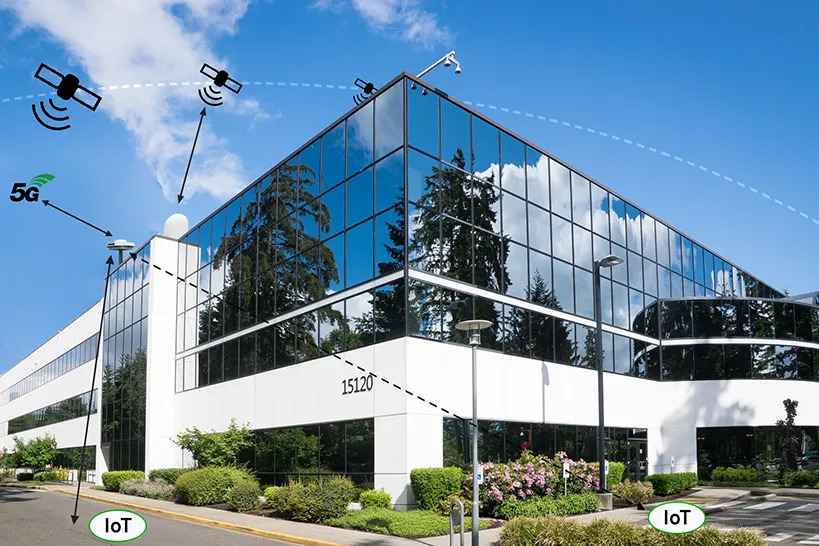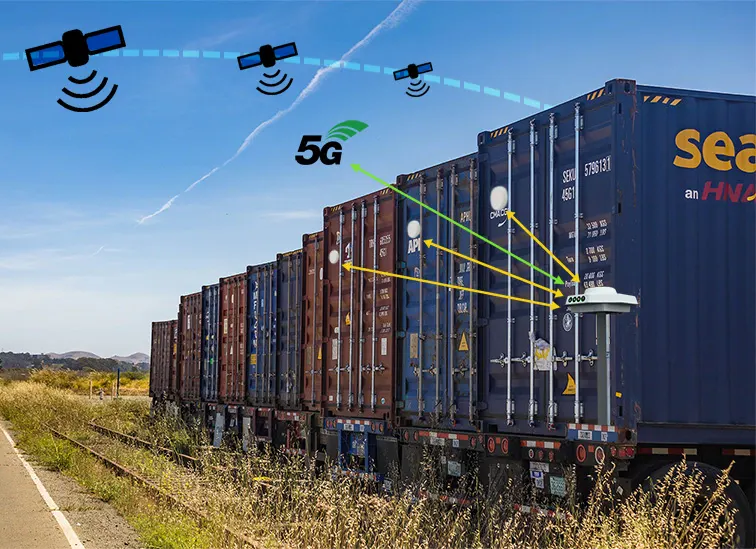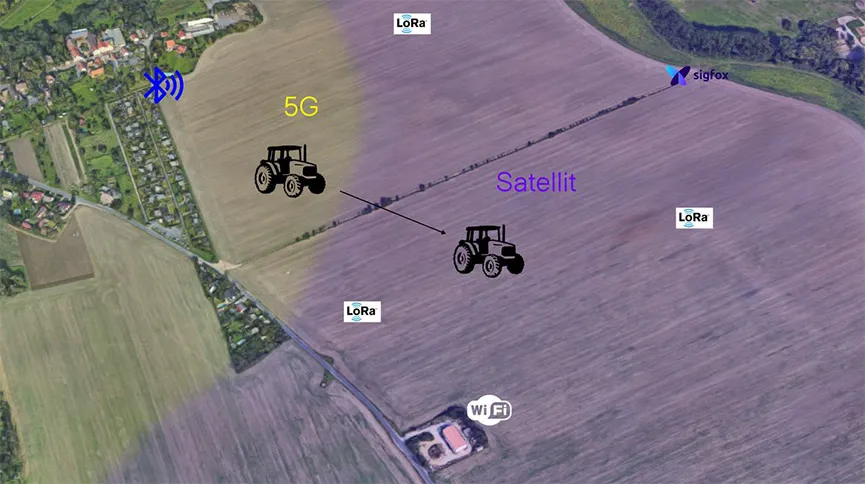Perseus MicroterminalConnectivity platform links independent communication networks together
Comprehensive Internet connectivity via satellite (LEO, GEO) and terrestrial networks (4G/5G/6G, WiFi6) through a connectivity platform
Project Description
The planned project, “Perseus Microterminals,” aims to develop a connectivity platform that aligns with the trend of providing internet connectivity everywhere. This connectivity platform will enable widespread connectivity via satellite and terrestrial networks. Moreover, it will support various independent communication networks, opening up applications where the availability of individual communication networks may vary or where increased demands for redundancy and communication security necessitate it. Simultaneously, it intends to cover a broad range of applications through the provision of extensive peripheral interfaces.
We intend the developed microterminals, for example, to serve as backhauls for distributed sensor networks as realized in LPWAN networks. We will create a base station for stationary or mobile sensor networks with redundant network connections by integrating low-energy transmission technologies like Sigfox, Dash7, or LoRaWAN.
Further aspects
Another aspect of the project involves developing a secure software infrastructure for managing distributed microterminals and connected peripherals. We will establish the integration into industrial applications through discussions with relevant stakeholders in system design. Additionally, we will provide support for terrestrial standards (4G/5G, WiFi6) and satellite services in geostationary and lower orbits (LEO1) by employing a modular design. The focus will be on expanding support for communication services via satellites in LEO orbits, ranging from bandwidth-limited “low-power applications” to broadband data connections on par with terrestrial radio connections in terms of “bandwidth” and “latency.”
We will investigate and implement the technological requirements for deploying the microterminal in both application scenarios during its development. Furthermore, EANT will pay special attention to 5G technology, as we have already specified automated selection of the best access technology, including satellites and other types of NTN2. Depending on advancements in standardization, this focus may also extend to the upcoming 6G technology.
Goal of the project: development of a connectivity platform that aligns with the trend of providing internet connectivity everywhere
The goal of the project is to develop a connectivity platform that, in line with the trend of providing internet access everywhere, enables comprehensive connectivity via satellite and terrestrial networks.
This innovation aims not only to tap into the classic market of mobile maritime satellite internet (maritime navigation, offshore drilling platforms, etc.) but also to explore new business areas and ensure the company’s future sustainability. EANT will transfer the solutions developed for using LEO networks to the maritime field, ensuring future security in this area. We will supplement and transfer the existing know-how in mobile satellite communication with geostationary satellites in terms of antenna technology, localization, and tracking to new applications.
The novelty of this project lies in the possibility of using various and completely independent connection options through a single connectivity platform, combining the respective benefits of network coverage, data rate, and energy consumption to create a new type of networking. We should also consider the modular approach in the antenna concept, capturing and utilizing possible synergy effects from the advancement of mobile and satellite communication standards.
The development toward distributed satellites in low orbits, for example, favors smaller terminals. Additionally, the expansion of the 5G frequency spectrum, especially in the Ka-band, approximates the frequency ranges traditionally occupied by satellite communication. In the project, we should examine and implement the use of communication-standard-agnostic apertures. This aims to achieve a high degree of miniaturization and flexibility. Consequently, we can offer an innovatively conceived technology, which provides significant added value, even in a traditional satellite communication application, and fully unleashes its potential after integration into shipping containers, vehicles, or cabins.
Global Market Situation and Application Scenarios
With the nearly ubiquitous availability of mobile communication services, a multitude of new markets and products have emerged that rely on constant internet connectivity. Requirements vary widely depending on the application area. Industrial applications, such as remote machine maintenance, for instance, demand extreme reliability and redundancy to ensure access even in emergency situations. Similar considerations apply to applications in emergency services or disaster management.

Consequences on the market
This growth is creating a growing market in the IoT segment, opening up new applications and generating a demand for technological solutions. In the agricultural sector, for example, the possibility and necessity of monitoring distributed sensor tags and connecting them through a stationary or mobile operable backhaul system is emerging. The broadband connection of the backhaul system can achieve 100% network coverage through the use of the microterminals described here, thereby independently supporting terrestrial and satellite-based radio technologies.

Current scenario
The current state of the art is that specific solutions exist for individual applications. Geostationary satellites offer services. Especially in the broadband segment for backhaul applications, parabolic dish antennas dominate. For the emerging LEO constellations, various solutions exist that, due to the suitability of flat-panel architecture, enable a higher degree of miniaturization, significantly smaller form factors, and greatly reduced power consumption. 5G routers and LoRa sensors come in various form factors, from USB sticks to DIN rails, and can be well-integrated into comprehensive system solutions. However, these devices are not designed for connecting additional sensors and can only achieve this through workarounds. Additionally, in most cases, the software used does not allow comprehensive user customization and remains tailored to specific use cases.Project Planning and Technical Challenges
1. Terminal-Hardware
A central development challenge involves designing the circuit for the main processing unit, which includes the motherboard and peripheral connections. The motherboard must meet the project’s broad range of requirements. This entails not only selecting and integrating the processor but also providing interfaces for various terrestrial and satellite-based modems.
Additionally, the system design should allow for flexibility to support the evolving 5G/6G standards of non-terrestrial networks and accommodate future innovations.
To further connect peripherals and sensors, we should implement an interface to LPWAN (Low Power Wide Area Network) networks.
Moreover, we must develop a modular housing to meet different application areas and modular requirements. We aim to integrate the terminal hardware into existing EPAK systems, enabling the resulting device to function as a Micro-ACU (Antenna Control Unit) that can be repurposed. Simultaneously, we are designing the system as an aperture-independent solution, with a particular focus on flat-panel antennas, which benefit greatly from ACU miniaturization.
Another key focus is the deliberate selection of electronic components. We prioritize transparent supply chains and extended availability to prevent supply chain shortages and ensure uninterrupted production as much as possible.
2. Terminal Software
The software development for the hardware platform described in point 1 can be broadly divided into the following areas: operating system and low-level driver development, power and traffic management, localization and antenna control, microterminal management, and distributed sensor management.
Based on the hardware design, we must make system-specific adjustments to the operating system and implement and test the customized version on the target hardware. Driver development primarily involves integrating different modem architectures, preferably through Mini PCI Express or M.2 interfaces. We should also explore and consider possible interface extensions for additional modem types. Furthermore, we must establish a basic interface for connecting “smart” apertures that rely on information from GNSS, inertial sensors, and associated modems for alignment and pointing.
Integration of inertial sensor and GNSS information
Integrating inertial sensor and GNSS information provides the basis for localization and antenna control algorithms. We will integrate essential interfaces and information for satellite identification and tracking, as well as necessary user interfaces. LEO-based satellite communication introduces new requirements for antenna terminals, particularly when high bandwidth is required. While a lower antenna gain is necessary due to the shorter distance between the terminal and satellite compared to geostationary satellites, some degree of focusing of radiation power is needed to achieve high bandwidth. Aligning the aperture requires reference information on antenna location and orientation, which is often only partially or imprecisely available.
Geostationary satellites with fixed reference points allow for a comparatively simple search pattern and provide a fixed reference point to determine the location of the antenna terminal. This is not the case in LEO applications, where the satellite’s location relative to the antenna terminal is constantly changing. To provide universal support for the LEO technologies of the Microterminal being developed, we should explore and develop various strategies for localization and position determination. This includes examining gyro-based NorthFinders and GNSS-based heading reference sources, as well as developing methods that allow for the omission of external reference information. We must assess the accuracy and suitability of these methods for different gain classes of the antenna aperture.
The importance of traffic management
Effective traffic management is crucial for this type of terminal due to its versatility. We need to divide data streams among available communication channels while considering the bandwidth and latency requirements of possible services. The system design must account for constantly changing dynamic requirements caused by varying signal quality and possible interruptions. Adherence to power and data limits is essential and should be configurable by the user.
In general, we must create a terminal management interface that provides users with diagnostic and configuration capabilities. Implementing a web interface for device-independent configuration is a viable option. Due to the multitude of competing services, we anticipate different requirements from various constellation operators, at least initially. Therefore, an open and extensively configurable management system in the background should simplify integration while maintaining flexibility.
In addition to pure data management and data transmission in distributed sensor applications, we must also create a frontend for user configuration and data output and processing. Establishing the foundation for an expandable sensor ecosystem is crucial, and we should consider integrating existing solutions whenever possible. In this regard, we should focus on utilizing and expanding existing open-source systems to provide easy access and a wide range of applications.
Antenna Development and Integration
To achieve the desired range of applications, we are planning various modular and interchangeable antenna implementations.
In the terrestrial environment, this involves antenna and aperture technologies for connecting to 5G standards and LPWAN networks.
In the field of satellite communication, we aim to implement a robust data connection with very low directional focus, as is standard in the IoT sector. Additionally, to demonstrate the capabilities and suitability of the system with LEO networks, we plan to integrate terminals into existing maritime and land mobile products.
Milestone planning
1: Mainboard specification
Upon completion of the “Mainboard Specification” milestone, all preparatory work on the mainboard will be completed, key components will be selected and integrated into the schematic. This is a prerequisite for work on the layouts, expansion cards, and software development.
2: Mainboard assembly + Testing
Upon completion of the “Mainboard Assembly + Testing” milestone, hardware development and the prototype assembly of the mainboard will be completed. This is a prerequisite for implementing the operating system and driver development.
3: Operating System
Upon completion of the “Operating System” milestone, the fundamental work on the operating system will be completed, and the operating system will be operational on the target hardware. Further software work will be based on this preliminary development.
4: IoT, 4G/5G Wireless Connectivity
Upon completion of the “IoT, 4G/5G Wireless Connectivity” milestone, expansion cards for terrestrial wireless connections will be developed and produced. Wireless connections will be established, and work on data management can commence.
5: SatCom + LEO
Upon completion of the “SatCom + LEO” milestone, the necessary interfaces to VSAT (Very Small Aperture Terminal) systems will be implemented, and all prerequisites for accessing and tracking LEO (Low Earth Orbit) satellites will be in place. This milestone provides the foundation for implementing “On The Move” LEO tracking algorithms.
6: Technology Demonstrator
Upon completion of the final “Technology Demonstrator” milestone, the technology demonstrator will be assembled, commissioned, and tested. The demonstrator will be used for the final presentation, demonstrating the functionality of all wireless connections. The integration and management of the IoT infrastructure into the terminal software will be completed with this milestone.
